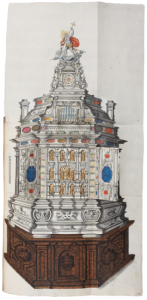 Ekphrasis and Court – Court culture and the travelogue in the age of confessionalization
Ekphrasis and Court – Court culture and the travelogue in the age of confessionalization
Conference and workshop of the DFG Long-Term Project “Annotated digital edition of Philipp Hainhofer’s (1578–1647) travel and collection accounts” (Herzog August Bibliothek Wolfenbüttel and Social History of the Artist Research Centre Trier) in cooperation with the Zentralinstitut für Kunstgeschichte Munich.
Munich, Zentralinstitut für Kunstgeschichte, 20th–22nd March 2020
In mid-2020, the Long-Term Project “Annotated digital edition of Philipp Hainhofer’s (1578–1647) travel and collection accounts” will have published all his travel accounts concerning Munich. A congress, marking this milestone, is planned to be held “on the spot” in Munich in March 2020 with the aim to focus on the edition’s issues of research and at the same time to broaden the geographical range.
The Augsburg art agent and diplomat Philipp Hainhofer visited the Bavarian capital seven times between 1603 and 1636. Apart from the two rather delicate diplomatic missions in 1629 and 1631 all stays are well documented. Hainhofer’s itineraries are excellent sources for art historical and historical research particularly with regard to the urban pattern of Munich in the early 17th century. He delivers a complex picture of the princely capital in the forefront of the Thirty Years’ War and in a denominational context.
The project envisages a one-day workshop and a subsequent colloquium of one and a half days. The workshop initiating the conference program will address questions that are focused on Munich around 1600 and Hainhofer’s travel accounts. During the colloquium we wish to address a wide reach of topics. A particular focus is laid on comparative aspects between the courts of the Holy Roman Empire.
We welcome proposals on (but not limited to) these topics:
Urbanistics/urban sociology
– court and (civil) city – an area of conflict and convergency
– the architecture and sculpture of the court as means of representation in public
The development of the court: palace, interior/spatial art, production and reception
– interior design, ceremonial and staged accessibility
– by means of religious and/or aesthetic contemplation encoded places of retreat
– organization of artist’s work, the architect as (artistic) director, concepts of authorship
– regarding Munich: e.g., the extension of the Munich Residenz and the princely country estates
Ekphrasis/Descriptio – descriptive culture around 1600
– its place in literary theory
– comparison of different genres of art description
– perception of cities in travelogues around 1600
– Kunstkammer and travelogue: comparative analysis of descriptions of Kunstkammern
– the artist in travelogues
– diplomacy and travelogue: controlling the social perception by princely hosts
– travelogues and graphic art as means of cultural exchange
Confessionalization, rivalry and perception of visual and material court culture
– arts and courts in the age of counter-reformation: Paragone and aemulatio
– mutual cultural transfer: ducal residence (e.g. Munich) – free imperial city (e.g. Augsburg) – imperial residence (Vienna, Prague)
– prearranged cultural transfer between the Catholic south and Protestant north (e.g. Philipp II of Pomerania-Stettin as recipient)
– perception of confessionalized courtly culture by Protestant recipients: such as relics (and the trading with) or the reputation of the Jesuits
The Thirty Years’ War and the ‘end of an era’
– perceptions of the aftermath of war
– its implications for the postwar material court culture
Contributions should not exceed 25–30 minutes. Please send abstracts (2000–2500 characters max), including a short bio, by 26 May 2019 to mwenzel@hab.de
A publication of the papers is intended.
source : https://arthist.net/archive/20637

Leave a Reply
You must be logged in to post a comment.